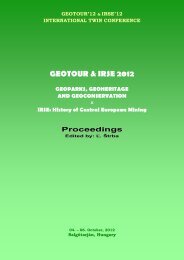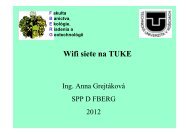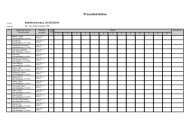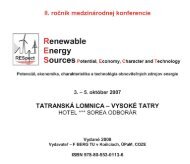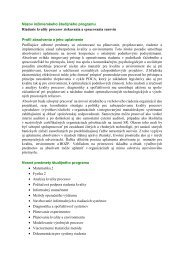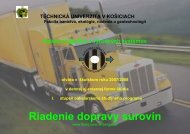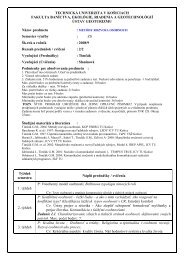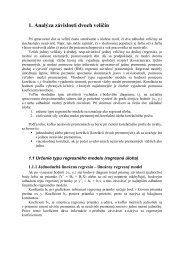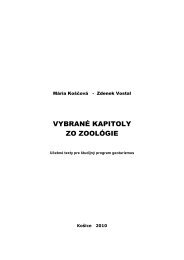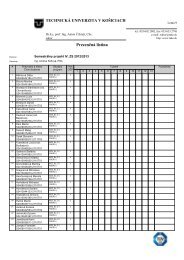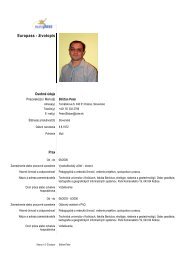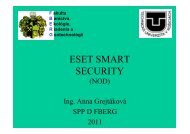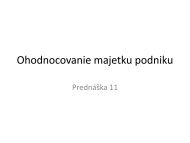GEOTOUR & IRSE 2012.pdf - Fakulta BERG - TUKE
GEOTOUR & IRSE 2012.pdf - Fakulta BERG - TUKE
GEOTOUR & IRSE 2012.pdf - Fakulta BERG - TUKE
You also want an ePaper? Increase the reach of your titles
YUMPU automatically turns print PDFs into web optimized ePapers that Google loves.
<strong>GEOTOUR</strong> & <strong>IRSE</strong> 2012<br />
in their surrounding or need to protect them in order to avoid danger to third parties etc.<br />
Remains of mining and often also metallurgical works, represent a valuable and rich source of<br />
knowledge concerning development of ore exploration technologies and also evidence of<br />
knowledge and skills acquired by generations of miners connected for centuries with Lower<br />
Silesia region.<br />
Information concerning history of mining exploration within Lower Silesia region are found<br />
inter alia in a series of documents originated by the former German State Mining Office based<br />
in Wrocław (German: Oberbergamt zu Breslau), which offers considerable resources<br />
concerning a period of time from 1779 to 1852 (subject to management of mining and<br />
metallurgical works in Silesia region by the said office).<br />
The main source publications for historical papers come from codes, which include names,<br />
summaries and full content of extracts from old chronicles. Moreover, the most significant<br />
volume of information is found in works by H. Festenberg-Packisch, E. Steinbeck and H.<br />
Fechner. A piece of work by H. Dziekoński, published among other works after 1945, is of a<br />
big significance and constitutes a rich source of information on history of ore mining within<br />
Lower Silesia region, together with works by E. and Z. Piątek.<br />
For centuries various mines were operated within Lower Silesia region. Gold, silver and lead<br />
ore, copper, tin, later also rock coal, arsenic and cobalt used to be great natural resources of<br />
the region. Lower Silesia was recognised as area of post-mining activity.<br />
Lower Silesia comprises six main regions, where useful ore deposits are found, i.e.: Ziemia<br />
Kłodzka (Kłodzko Land comprising Kłodzko Valley and surrounding Sudetes), Owl<br />
Mountains including surroundings of Wałbrzych, foot of Karkonosze, exploited gold sand<br />
deposits near Lwówek, Złotoryja and Legnica.<br />
Condition of the preserved historic relics within Lower Silesia varies to a significant extent.<br />
Research and documentation works conducted within them have revealed both barely visible<br />
cavities, marking direction of adits and bottom roads explored at low depths, or collapsed pit<br />
shafts, as well as perfectly-preserved excavations with fragments of their housings, pieces of<br />
equipment etc. It is a concept of high significance for issues connected with development of<br />
post-industrial structures since its properties such as accessibility, technical condition, tourists<br />
value, will have a key meaning for estimation of investment expenses to be borne in order to<br />
revive a given structure (Madziarz et al, 2005).<br />
CONCEPTUAL STAGE OF THE INVESTMENT PROJECT<br />
Field research, evaluation of tourist value of a given region as well as results of feasibility and<br />
profitability analysis of the investment project constitute basic requirements of a revitalization<br />
project aiming to restore old post-mine structures to life. Comprehensive approach will allow<br />
to identify potential application of natural, technical and technological values. It is generally<br />
believed that post-industrial area is nothing but wasteland and accumulation of waste, which<br />
significantly decreases value of a given region.<br />
Relevant features either positive, which speak in favour of some initiative, or negative which<br />
speak against initiatives under consideration, are taken into account in order to establish a<br />
specific character of chosen facilities. Such approach allows to choose the best direction for<br />
use of facilities and their development, and points at prospects and risks. Choosing a structure<br />
is not a difficult stage of the project. It is execution of next stages and adaptation works that<br />
may present some difficulties.<br />
123



